
SRT201
(1975) In 1975, Minolta "upgraded" the original SRT100 series to the SRT200
series. Actually, there was very little difference between the two
series of cameras. Perhaps Minolta felt that the SRT100 series name
was getting too old and that the public wanted something "new". After
all, the early 1970's saw dramatic competition in the camera market, and
other camera companies were producing "new" cameras with new names -- some
with very minor changes. For example, Nikon added a hot shoe to it's
Nikkormat FTN in 1975 -- and called it the Nikkormat FT2. In the same
vein, Minolta made some minor changes to all of the Minolta SRT100 series
cameras -- and the SRT200 series was born.
The SRT201 was a modified version of the SRT101.
There were actually several versions of the SRT201, depending on the
market, with slight variations over time. The model numbers are not
inscribed on the cameras.
-
SRT201 (model a) -- (1975)

The first model of the SRT201 was almost exactly like its predecessor, the
SRT101, but it had the addition of a hot flash shoe
on the pentaprism, and a film memo holder on the back. The new film memo
holder retains the ASA/DIN converter, but you can't see it if you have a
film tab inserted. But there were sublte differences as well. The previous
model had "MINOLTA CAMERA CO.,LTD." imprinted on the top between the pentaprism
and the rewind crank. On this model, the imprint is gone. In addition, the
film plane indicator, which had been behind the shutter speed dial (on the
right), is now placed between the pentaprism and the rewind crank (on the
left). This was a smart move and makes measurements a little easier for those
few people who use it. Last, the hot shot on this model is marked with a
red "X", hopefully to remind users that the "hot" part of the shoe is only
usable with X-synch, not bulbs. The viewfinder and focusing screen remained
the same:

The SRT201 (model a) was available in black or chrome.
-
SR101 -- (1975)
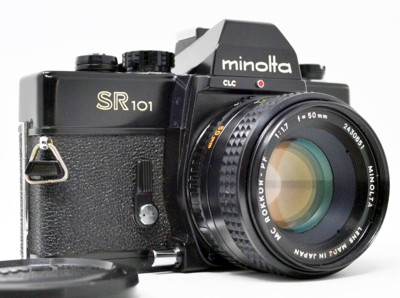
Japanese version of the SRT201 (model a). This camera should not be
confused with the SRT101.
-
SRT101b (model a) -- (1975)

European version of the SRT201 (model a). This camera should not be
confused with the SRT101.
-
SRT201 (model b) -- (1977)

In 1977, several changes were made to the SRT201 (model a). This was
the same year that Minolta introduced the first of the XD and XG cameras,
and several of these features were copied directly from the XD and XG line.
Perhaps it was an attempt to make the older-styled cameras look as
similar as possible to the newer cameras, but it is just as likely that the
newer parts were available -- and usable -- on the older cameras. First,
there was a switch on the SRT201 (model b) to a black, plastic aperture ring
around the lens mount -- replacing an aluminum ring.
In addition, the locking DOF button of the earlier SRT cameras was replaced
with a non-locking DOF button. On the surface, this sounds like a minor cosmetic
change. But the change is more than skin deep. At the same time, Minolta
dropped the "meter off" switch which, in all previous SRT models, would
automatically turn the meter off when the DOF button was pressed (when an
MC lens was attached to the camera). The purpose of this early feature
was to allow metering in "stop-down" mode with early non-MC lenses. That's
why the DOF button on Minolta SLR cameras was originally called the
"stop-down-metering" button. So with this switch, Minolta was cutting out
a few cents in manufacturing costs -- and casting aside users of earlier
lenses.
Also, the SRT201 (model b) only had X synchronization for flash use -- the
FP option of the SRT201 (model a) was dropped. The SRT201 (model b)
was available in black or chrome. Look for the black, plastic aperture
ring around the lens mount and the microprism-only focusing screen to identify
the SRT201 (model b).
-
SR101s (model a) -- (1977)

Japanese version of the SRT201 (model b). This camera should
not be confused with the SRT101.
-
SRT101b (model b) -- (1977)
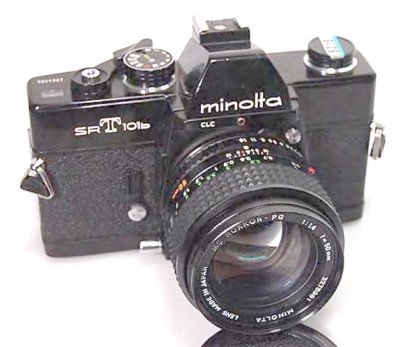
European version of the SRT201 (model b). This camera should
not be confused with the SRT101.
-
SRT201 (model c) -- (1978)

In 1978, Minolta made an important change to the SRT201 (model b). The
microprism-only focusing screen was updated with a slightly brighter screen
having a split-rangefinder in the middle of the microprism circle -- like
that of the SRT202.
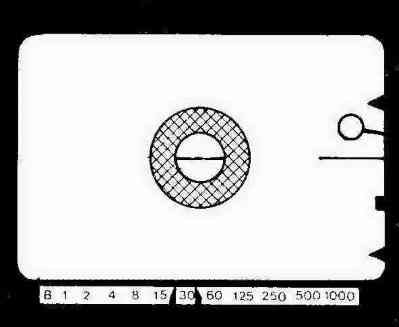
Perhaps this is was why Minolta dropped the production of the
SRT202 at this time. Except for not displaying
the f-stop in the viewfinder, there just weren't many differences left between
the SRT201 (model c) and the SRT202. The SRT201
(model c) was available in black or chrome. Look for the split-rangefinder
in the middle of the microprism circle and the CLC marking to identify the
SRT201 (model c).
-
SR101s (model b) -- (1978)

Japanese version of the SRT201 (model c). This camera should
not be confused with the SRT101.
-
SRT101b (model c) -- (1978)

European version of the SRT201 (model c). This camera should
not be confused with the SRT101.
-
SRT201 (model r) -- (1978)
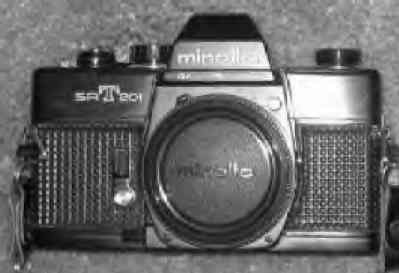
In 1978, Ritz Camera negotiated with Minolta to create a special version
of the SRT201, hence the "model r" designation. This model was only available
in the US, and there it was only available through the Ritz's camera shops
-- so they are hard to come by these days -- and highly priced by the few
collectors that actually know about them. The obvious difference is that
the body has a notched, rubberized covering instead of the standard leatherette.
The covering is virtually identical in appearance to that used on the
focusing rings of the Rokkor-X lenses. Some people love the waffle-covering
because it matches the lens appearance of the lenses so well, and helps assure
a firm grip on the camera. Others find it very hard and, as a result, much
less comfortable -- even irritating -- when compared to the standard leatherette.
We'll let YOU decide -- should you ever find one! The only other difference
is that the SRT201 (model r) used the old style focusing screen without the
split-image rangefinder. Maybe Minolta had a bunch of left-over screens that
they needed to use up. Maybe they didn't want the SRT201 (model r) to be
a full-blown competitor to the SRT (model c). Who knows? The
SRT201 (model r) was available in chrome or black, but most of the people
who pulled out the stops to get this expensive, stylish covering apparently
went for the black. No big surprise there. The Minolta
XK was also produced in a "model r".
-
SRT201 (model d) -- (1979)

In 1979, the SRT201 saw a final round of changes. First, there was
a new rewind knob -- styled like that in the XG cameras. In addition,
the PC contact was no longer marked with an "X". OK, I know none of
these are big deals. How about this? Lastly, one of the two internal CDS
cells was dropped in the SRT201 (model d), so this model lacks the CLC feature
common to all of the earlier SRT cameras. This model can quickly be
identified by the lack of the "CLC" marking on the front -- although the
first batch of SRT (model d) cameras was marked "CLC" even though they lacked
the CLC feature. Apparently Minolta had a bunch of "CLC"-marked
top covers that they needed to use up!
-
SR101s (model c) -- (1979)

Japanese version of the SRT201 (model d). Never sold in Japan.
This camera should not be confused with the SRT101.
-
SRT101b (model d) -- (1979)
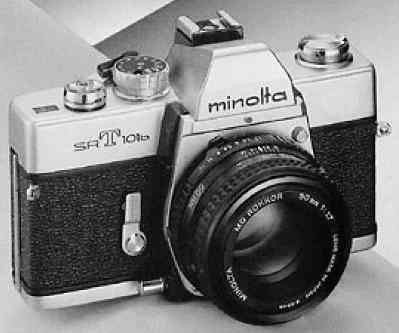
European version of the SRT201 (model d). This camera should
not be confused with the SRT101.
The SRT201 was manufactured from 1975 into the 1980's, when it was dropped.
It was the last Minolta SLR camera with a non-battery-dependent shutter,
so it will always have a special place in our heart. It was the last
model in a long, successful line of well-designed, well-built, easy-to-use
SLR cameras, going back all the way to 1958. With the development of
the auto-exposure cameras (1972), and then the auto-focus cameras (1985),
Minolta saw a drop in demand for it's manual-everything cameras. The fact
that their marketing budget supported auto-focus cameras, and not manual-focus
cameras, played an important part. Fortunately, you and I know that the more
control a photographer has, the better the results will be.
Given the addition of the split-image focusing screen and a hot shoe, the
SRT201 (especially the later models) is a perfect camera for many photographers.
It competes well in a feature-comparison with the
SRT102 and SRT202. And
with Rokkor lenses, the SRT201 provides the exact same picture quality as
any of Minolta's higher priced models. Best of all, the SRT201 is still
available at amazingly low prices on the used market -- often cheaper than
the earlier SRT101. For a comparative look
at the major features of the SRT201 models, check out
MINMAN's SLR table
-- the world's most complete!
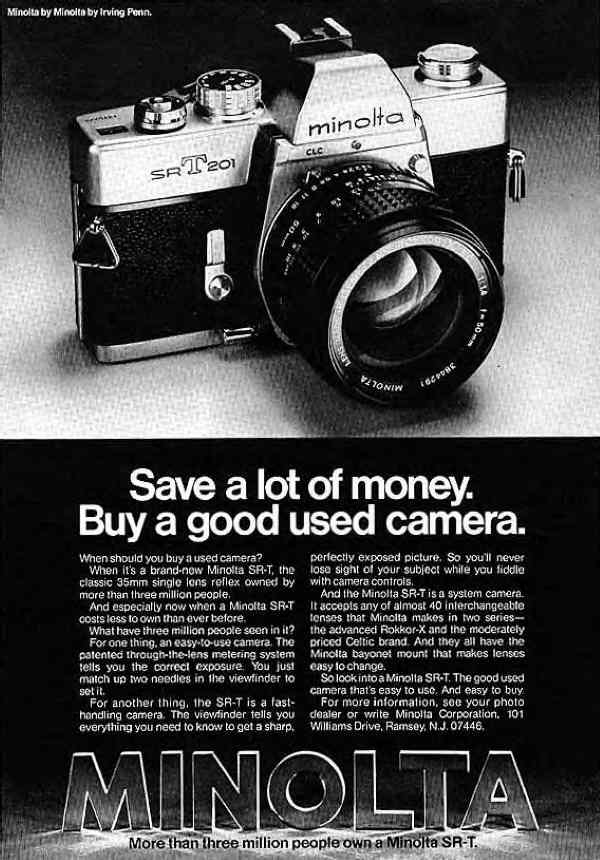
RETURN TO THE MANUAL
MINOLTA HOME PAGE
We didin't want to do this, but since other websites have been stealing our
stuff, we have no alternative but to state:
COPYRIGHT@1995-2023 by
Joe McGloin.
All Rights Reserved. The material on this website is protected by US Federal
copyright laws. It cannot be copied or used in any manner without specific
approval from the owner.

















